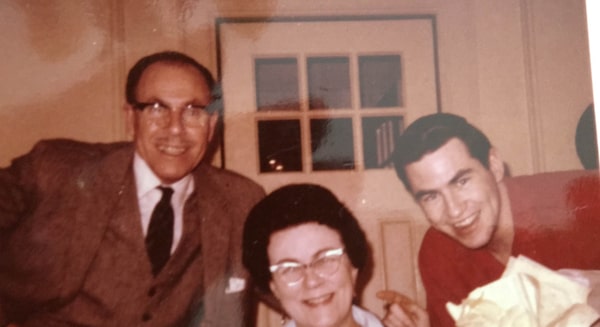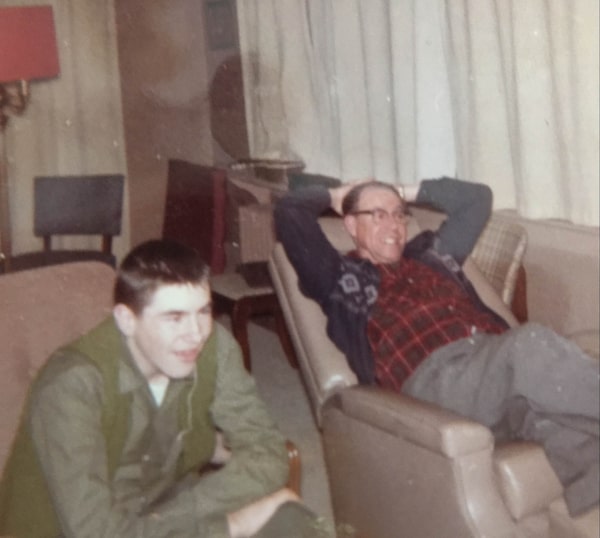
More remarkable than the admittedly poor audio quality of the performance itself is George Drynan’s off-the-cuff interviews with St. John Ambulance attendants and crowd members, all of whom assumed he was a reporter owing to his button-down appearance and professional manner.
On Aug. 17, 1966, amid the din and hullabaloo of what would be the last-ever Beatles concert in Canada, nobody seems to have noticed the middle-aged man in the stands with a reel-to-reel tape recorder. He was George K. Drynan, QC, a day-tripping father of three, war veteran and sedan-owning Rotarian who travelled to Toronto’s Maple Leaf Gardens from Oshawa, Ont., with his wife – the accomplished organist, composer and choirmaster Margaret (Peggy) Drynan – and a family friend. The oldest son, John, handled the driving. Younger son James also attended the show, but had arranged separate transportation.
George Drynan was a colourful, outspoken fellow who carried a cane he used more as a gestural exclamation point than for assistance in walking. Set against the horde of scream-faced teenyboppers at a sweltering Beatles concert, the tie-wearing man couldn’t have stood out more.
And yet Drynan at the Gardens was left to his unlikely business, which was, when all was said and done, to unwittingly document an essential slice of Canadiana and record one of the most absorbing bootleg tapes in rock ’n’ roll history.

Drynan attended the Aug. 17, 1966 concert at Toronto’s Maple Leaf Garderns with his wife, Margaret (Peggy) Drynan, and his two sons, John and James.
The recording was recently acquired by the University of Toronto Libraries. Admittedly, the listenability of the performances themselves – including a short set by the Beatles and those of opening acts that included the Ronettes – is not exceptional. If rugged material such as Long Tall Sally struggled to be heard, the more delicate Yesterday and Nowhere Man stood no chance at all.
What are remarkable are Drynan’s off-the-cuff interviews with St. John Ambulance attendants and crowd members, all of whom assumed he was a reporter owing to his button-down appearance and professional manner.
Even more captivating are the preconcert and postshow observations of the Drynans. Paul was the one who added a “flash of youth” to the Beatles, according to the husband. John is hairy. Is George the “gaunt” one?
He was.
Paul McCartney plays with the Beatles on stage at Maple Leaf Gardens on Aug. 17, 1966, in Toronto. It was the last Canadian performance for the band, who would never tour again after that summer.Graham Bezant
The Beatles performed a pair of concerts that August day, with the Drynan family attending the second of the two – the “evening show.” It was a simpler, gentler, Ozzie-and-Harriet time. “It’s 7 p.m. on a beautiful evening,” Drynan is heard saying, in a high, nasal voice as the family made its way to the concert. “We’re on our way. …”
That they were, on their way – and so, too, were the Beatles, who never toured again after the summer of 1966. The year also marked a turning point in cultural and societal history. Things switched from black and white to colour, The Adventures of Ozzie and Harriet went off the air and families stopped going to rock ’n’ roll concerts together.
The recording made by Drynan on his German UHER portable deck is often referred to today as “the Amos Tape” among bootleg collectors. John Amos was an American collector who purchased the tape and the original recorder from James Drynan, who came into their possession when his father died in 2000.
Amos had promised to pay the Drynan son $10,000 for the tape and deck (still in its original leather case), but ultimately coughed up much less. “I was foolish,” James Drynan told The Globe and Mail last month. “I shouldn’t have done it.”
That was in 2007 or 2008. Not long after that, when the tape and recorder were back on the market, Library and Archives Canada considered obtaining them. After it backed out of acquiring the pieces of pop-culture Canadiana, the Toronto-based Beatles historian Piers Hemmingsen stepped up and purchased them himself in 2008. “It’s an amazing piece of Canadian history, and it belonged here,” Hemmingsen says today.
After holding onto the tape and tape deck for nearly a decade, Hemmingsen, author of The Beatles in Canada: The Origins of Beatlemania!, recently donated them, for a tax receipt, to the University of Toronto Libraries. “I think it was the right time. You can’t keep everything forever.”
If possessions are transient, so are eras. Some of the commentary on the tape was quite prescient in regard to changes soon to happen. The father remarks that the “bloom was off the peach” for the Beatles, which was an assessment backed up by Globe and Mail reporting at the time. “It was certainly a far cry from their first two appearances here,” wrote the concert reviewer, who noticed less excitement from the crowd. “It almost seemed that what could be the Beatles’ last appearance in Toronto might fall flat on its crumpet.”
It had been a rough year for the band. In July, tour dates in Manila were a disaster after the Beatles snubbed an invitation to the state palace by the noted shoe enthusiast and dictator’s wife Imelda Marcos. Singing Help! on stage became an authentic plea from the foursome when they barely made it out of the Philippines with their mop tops intact after an angry mob of nationalists roughly hassled them on the way to the airport.
The Beatles, from left: Ringo Starr, Paul McCartney, George Harrison and John Lennon, attend a news conference at Maple Leaf Gardens prior to their concert.Fred Ross
In March, 1966, Lennon, the hairy one, had made his infamous “we’re more popular than Jesus” remark to a British newspaper. The comment lay dormant until the Beatles hit North America in August, where religious zealots in some markets protested the band aggressively.
Add to all that, in the mid-1960s the business of rock ’n’ roll touring was relatively unsophisticated. The sound quality in arenas and stadiums was unsatisfactory for both audiences and musicians; twisting, shouting and fanatical shrieking further added to the disharmony.
None of that infringed on the Drynan family’s Beatles experience at Maple Leaf Gardens. On the tape, Dad notes he was held in “great prestige” among younger members of his office staff for attending the concert. The family friend judges the Beatles as a “great singing group,” and thought it would be “very interesting” to see them live. After the show, Drynan suggests refreshment: “I think we should stop somewhere for a cup of tea.”
Drynan had been an officer in the Canadian Army during the Second World War and was wounded in Italy. Being a lawyer, he was involved in the war-crimes trial in postwar Germany of Kurt Meyer, a German Panzer officer who ordered the execution of Canadian prisoners of war in Normandy. Returning home from Europe, Drynan was a dedicated Liberal well known in Oshawa.
“George was always definite about everything,” Oshawa MP Ivan Grose told the House of Commons, upon Drynan’s death on Sept. 28, 2000, the same day Pierre Trudeau died. “We knew where he stood and damn the torpedoes. He called me regularly with advice I was to convey to the Prime Minister, Minister of Finance and Minister of Justice. I passed on to these ministers a great deal of what George said and, amazingly, some of it bore fruit.”
(If Drynan was colourful, Grose was Technicolor. In his 20s in the 1950s, bored out of his mind as a telephone-company salesman, he decided to rob a bank – as one does. Less than streetwise, he was easily caught by a pistol-waving bank manager and served 19 months of a three-year sentence. At present, he is the only convicted bank robber ever to serve in the House of Commons.)
The Beatles show at the Gardens was the first concert for youngest son James Drynan. His older sister, who lived in England at the time, had bought him an outfit of pinstripe pants, a psychedelic shirt and a spiffy jacket and tie on Carnaby Street in London.
John Lennon sings to the Maple Leaf Gardens crowd in Toronto.Graham Bezant
Speaking from his home in Gatineau, Drynan tells a story that gets to the sheer hysteria brought on by a Beatles appearance. Talking to a girl in the stands as the main act was about to hit the stage, he bet her $1 that she wouldn’t be able to refrain from screaming for a full minute when the Beatles appeared.
The girl took the wager.
A few minutes later a roadie adjusted Ringo Starr’s drum kit. According to Drynan, the girl instantly screamed, fainted and was quickly taken away by ambulance attendants. She missed the show, the Beatles were soon finished as a live band and Drynan never got his dollar. An era was done; all bets were off.
“Things changed after 1966,” says Fergus Hambleton, a Toronto musician who, as a 16-year-old, attended the same Beatles concert. “Walls went up between parents and their children. The drugs and the music got harder. There was protest music before, but it didn’t have the nihilistic anger that came later.”
John Macfarlane, who covered the Beatles concert for The Globe and Mail, agrees. “In 1966, I couldn’t have imagined anyone like Jimi Hendrix. He had a raw, and to my mind anyway, angry energy.”
By 1968, Macfarlane (the future editor of magazines Toronto Life and The Walrus) was the Toronto Star’s entertainment editor. It was in that capacity that he assigned features writer David Lewis Stein to cover the riotous 1968 Democratic National Convention in Chicago. “I think the fact that an entertainment editor, two years after that Beatles concert, was commissioning a writer to attend that convention, shows you how quickly culture had become politicized.”
The senior Drynan also attended the Democratic convention. Upon his return, when he downplayed the significance of the events there, his youngest son took exception.
“What they did there was try to stand up, and they got beaten down by the Chicago police force and Mayor Richard Daley,” says James Drynan, who by that time had become a guitarist and moved to Toronto, where he played in bar bands even though he was underage. “The establishment was trying to put the youth back in its place.”
Son and father argued the cross-generational disputes that were common in the late 1960s. “We didn’t get along as well after that,” recalls James Drynan. “The world was changing.”
Asked about the Beatles concert at Maple Leaf Gardens, Macfarlane says he doesn’t remember all that much, mostly because of all the crowd noise. “If you went hoping to hear the music rather than to experience the fervour, it was kind of a disappointment.”
The Beatles, feeling the same way, pulled themselves from the road. Less than a year later came Sgt. Pepper’s Lonely Hearts Club Band, an elaborate studio album on which they sang something of a curtain call: “We hope you all enjoyed the show.”
Beatlemania was finished, and an uncomplicated kind of culture was gone as well. On the Drynans’ famous family bootleg recording, one can hear it all happening. But what were heard as screams at Maple Leaf Gardens then should be interpreted, in retrospect, as the last gasps of a dying era.
 Brad Wheeler
Brad Wheeler